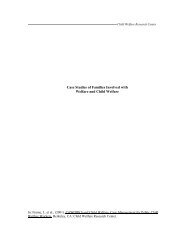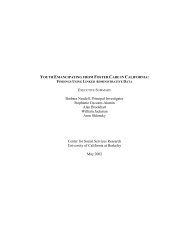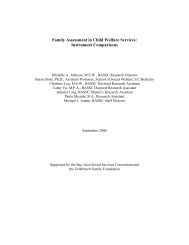COSMOS Corporation, October 2003 2-7StudyCross, et al., “Towards a <strong>Culturally</strong> CompetentSystem <strong>of</strong> Care: A Monograph on EffectiveServices for <strong>Minority</strong> Children Who are SeverelyEmotionally Disturbed,” 1989Adams, ed., Health Issues for Women <strong>of</strong> Color: ACultural Diversity Perspective, 1995Campinha-Bacote, “The Process <strong>of</strong> CulturalCompetence,” State <strong>of</strong> Washington, Department<strong>of</strong> Health, 1995Orlandi, ed., Cultural Competence for Evaluators:A Guide for Alcohol and Other Drug AbusePrevention Practitioners Working WithEthnic/Racial Communities, 1995Association <strong>of</strong> Asian Pacific Community HealthOrganizations, State Medicaid Managed Care:Requirements for Linguistically Appropriate HealthCare, 1996Lavizzo-Mourey and Mackenzie, “CulturalCompetence: Essential Measurements <strong>of</strong> Qualityfor Managed Care Organizations,” 1996National Maternal and Child Health ResourceCenter on Cultural Competency, Journey TowardsCultural Competency: Lessons Learned, 1996Tirado, Tools for Monitoring Cultural Competencein Health Care, 1996Andrulis, “Toward a More <strong>Culturally</strong> CompetentSystem <strong>of</strong> Care: Implications for Federal Policy,Managed Care Provider and Communities,” 1997McManus, ed., “Services to <strong>Minority</strong> Populations:Cross-cultural Competence Continuum,” 1998Source: CLAS in MCOs Study (OMH 2003b)Exhibit 2-1SELECT DEFINITIONS OF CULTURAL COMPETENCEAND CULTURALLY APPROPRIATE HEALTH CARE SERVICESDefinitionCultural competence: Organizations have formal policies, such as mission statements, specifically expressing acommitment to cultural diversity.Cultural competence: Cultural or ethnic competence refers to the development <strong>of</strong> skills that will help people behavein a culturally appropriate way with a given group, demonstrating both sensitivity to cultural differences and similaritiesin the effective use <strong>of</strong> cultural symbols in interactions and effective communications with members <strong>of</strong> diversepopulations. (The definition continues.)Cultural competency: “a set <strong>of</strong> behaviors, attitudes and policies <strong>of</strong> a system, agency or individual that enables thatsystem, agency or individual to function effectively in trans-cultural interactions...and a person’s or programs’s abilityto honor and respect the cultural differences (beliefs, interpersonal styles, attitudes and behaviors) <strong>of</strong> individuals andfamilies who are clients, staff administering programs, and staff providing service at state and local levels. In doingso, it incorporates values at the levels <strong>of</strong> policy, administration, and practice.”Cultural competence: a set <strong>of</strong> academic and interpersonal skills that allow individuals to increase theirunderstanding and appreciation <strong>of</strong> cultural differences and similarities within, among, and between groups. Thisrequires a willingness and ability to draw on community-based values, traditions, and customs, and to work withfocused interventions, communications, and other supports.<strong>Culturally</strong> appropriate services: “effectively identify the health practices and behaviors <strong>of</strong> target populations todesign programs, interventions, and services which effectively address cultural language barriers to the delivery <strong>of</strong>appropriate and necessary health care services.”Cultural competence: the integration <strong>of</strong> 1) health-related beliefs and cultural values; 2) epidemiology; and 3)treatment efficacyCultural competency: “a program’s ability to honor and respect beliefs, interpersonal styles, attitudes, and behaviors<strong>of</strong> families who are clients, as well as the multicultural staff who are providing services. It incorporates these values atlevels <strong>of</strong> policy, administration, and practice.” Cultural competency is viewed as a continuum, not as a one-time goal.“Competency implies skills which helps to translate beliefs, attitudes, and orientation in action and behavior in the dailyinteraction with children and families.”Cultural competency: level <strong>of</strong> knowledge-based skills required to provide effective clinical care to patients from aparticular racial or ethnic groupCultural competency: “effectively incorporating the ethnic/cultural characteristics <strong>of</strong> individuals and their health careneeds and in promoting health, and working to achieve the highest quality care.”Cross-cultural competency: “the knowledge and interpersonal skills that allow providers to understand, appreciate,and work with individuals from cultures other than their own. It involves an awareness and acceptance <strong>of</strong> culturaldifferences, self-awareness, knowledge <strong>of</strong> the patient’s culture, and adaptation <strong>of</strong> skills.”
2.1.6 Identifying Key Components <strong>of</strong> CLASSeveral characteristics or services emerged from the literature as important for healthcare agencies to be considered “culturally competent.” These key components for culturalcompetence (described below) provided the basis for adopting the MCOs study conceptualframework (with eight assessment domains) that is detailed in Section 2.2.Organizational Governance and Policy Development. To be considered “culturallycompetent,” health care organizations should have formal policies such as written missionstatements that specifically express a commitment to cultural diversity (Cross et al. 1989)and policies governing translation and interpretation services (The Asian and PacificIslander American Task Force [APIATF] 1997; National Public Health and HospitalInstitute [NPHHI] 1998). Community members should be recruited for policy-makingpositions, such as general oversite committees and task forces, and should be wellrepresented on new task forces that can be created to study, evaluate, and address issuesrelated to culturally appropriate care (Cross et al. 1989; Roberts et al. 1990). Strategicplanning committees and other decision-making bodies should be representative <strong>of</strong> thecommunity, in race and ethnicity, as well as other characteristics such as gender and age(APIATF 1997; National Latino Behavioral Health Workgroup [NLBHW] 1996;Washington State Department <strong>of</strong> Health 1998).<strong>Culturally</strong> Inclusive Health Care Environment and Practices. An importantstrategy for addressing the health care needs <strong>of</strong> culturally diverse populations is torecognize and learn about a patient’s perspective concerning illness (Randall-David 1989).Understanding cultural perceptions about disease is critical to effectively engagingindividuals in disease prevention and treatment activities (Frye 1993; Saint-Germain andLongman 1993). Also, providers’ understanding <strong>of</strong> cultural differences in familialrelationships and roles is <strong>of</strong>ten important for effective treatment plans (Ahn and Gilbert1992). Moreover, health care providers may collaborate with traditional healers to learnmore about patients’ use <strong>of</strong> traditional healing methods in an effort to provide moreculturally competent care (APIATF 1997; NLBHW 1996) and utilize practices that arerespectful <strong>of</strong> and responsive to patients’ cultural backgrounds, e.g, diverse religiousservices and facilities or dietary options available (NPHHI 1998).Also important for culturally competent care are providers’ awareness about theirown values and how they may bias interactions with individuals from different cultures(Dilworthanderson et al. 1993; Eliason 1993; May 1992). To improve patient care,providers are encouraged to assess their own beliefs and have knowledge <strong>of</strong> generalethnic, regional, and religious beliefs and practices before discussing health care issueswith patients (Price and Cordell 1994).COSMOS Corporation, December 2003 2-8
- Page 1 and 2: Developing a Self-Assessment Toolfo
- Page 3 and 4: ContentsChaptersPage1. Introduction
- Page 5 and 6: Chapter 1Introduction
- Page 7 and 8: While many LPHAs currently provide
- Page 9 and 10: LPHAs include: adult and child immu
- Page 11 and 12: Professions Education Partnership A
- Page 13 and 14: Chapter 2Methodology for Developing
- Page 15 and 16: Public Health Practice Program Offi
- Page 17 and 18: assess their own beliefs and have k
- Page 19: communicate with, and clearly under
- Page 23 and 24: Given these persistent disparities
- Page 25 and 26: (Exhibit 2-2, Continued)DOMAIN / KE
- Page 27 and 28: limited to the actual clinical enco
- Page 29 and 30: Chapter 3Project Results and Recomm
- Page 31 and 32: local board of health. PEP and PAG
- Page 33 and 34: numerous promising CLAS practices a
- Page 35 and 36: References
- Page 37 and 38: Becker, M.H., and L.A. Maiman, “S
- Page 39 and 40: Frye, B., “Health Care Decision M
- Page 41 and 42: Marin, G., “Defining Culturally A
- Page 43 and 44: Perkins, Jane, “Overcoming Langua
- Page 45 and 46: U.S. Bureau of the Census, “Censu
- Page 47 and 48: Appendix AMembership Lists of the P
- Page 49 and 50: Appendix A-1Developing a Self-Asses
- Page 51 and 52: Appendix A-2Developing a Self-Asses
- Page 53 and 54: Appendix B-1Overview of Eight CLAS
- Page 55 and 56: Domain 3: Culturally Inclusive Heal
- Page 57 and 58: understanding of diversity issues i
- Page 59 and 60: Appendix B-2Conceptual Framework fo
- Page 61 and 62: Appendix CLPHA Director or Designee
- Page 63 and 64: Pre-Interview Script for LPHA Direc
- Page 65 and 66: 3b. Which of the following are refl
- Page 67 and 68: 6. Does your agency have a formal p
- Page 69 and 70: 10. Which of the following describe
- Page 71 and 72:
Post-Interview Script for LPHA Dire
- Page 73 and 74:
Appendix DStaffing Questionnaire
- Page 75 and 76:
A. QUALITY MONITORING AND IMPROVEME
- Page 77 and 78:
B. MANAGEMENT INFORMATION SYSTEMS (
- Page 79 and 80:
7. Please indicate, if you know, th
- Page 81 and 82:
1c. Please indicate for which categ
- Page 83 and 84:
6. Please indicate for which catego
- Page 85 and 86:
10. Which of the following topical
- Page 87 and 88:
17. Which of the following benefits
- Page 89 and 90:
4. Which of the following strategie
- Page 91 and 92:
Appendix EClient Services Questionn
- Page 93 and 94:
A. QUALITY MONITORING AND IMPROVEME
- Page 95 and 96:
6b.Which of the following community
- Page 97 and 98:
3. Please report or estimate what p
- Page 99 and 100:
3. Which of the following practices
- Page 101 and 102:
Oral Interpretation Services10. Whi
- Page 103 and 104:
16. At which of the following key e
- Page 105 and 106:
3. Which of the following kinds of
- Page 107 and 108:
Appendix FPilot Test Response Form
- Page 109 and 110:
RESPONDENT EVALUATIONOF THE QUESTIO
- Page 111 and 112:
Appendix GCLAS in MCOs Study Data C
- Page 113 and 114:
position, as titles will likely var
- Page 115 and 116:
complex and uncertain at the time t
- Page 117 and 118:
1. Incorporate a confirmation pre-c
- Page 119 and 120:
Exhibit 2DATA COLLECTION PROCESSSen
















